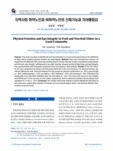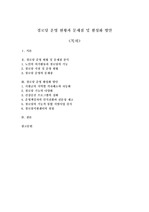

-
서지정보
· 발행기관 : 한국노인간호학회
· 수록지 정보 : 노인간호학회지 / 16권 / 1호 / 27 ~ 37페이지
· 저자명 : 김효영, 박명화
초록
Purpose: This study was done to identify frail and non-frail elders in a local community based on the definitionsof frailty and to compare physical function and ego-integrity. Methods: Data were collected from August 1 toSeptember 20, 2008 with 196 community-dwelling elders in Korea. Physical function was defined using physicalperformance, grip strength, walking speed, eye sight, hearing, chewing, activity of daily living, and ego-integrity. Five questionnaires with incomplete responses were not included in data analysis. Results: Of the 191 elders,37.2% were categorized as being in the frail group and 62.8% in the non-frail group. For physical function, significantdifferences were observed between the two groups for physical performance (p<.001), grip strength(p<.001), walking speed (p<.001), eye sight (p<.001), hearing (p<.001), and chewing (p<.001). Frail elders hadsignificantly more ADL/IADL limitations than non-frail elders (p<.001). The mean total scores for ego-integritywere 89.68 and 112 for frail and non-frail elders, respectively, and the difference between the two groups wassignificant (t=-11.90, p<.001). Conclusion: The results of the study indicate a need to identify the frail elders inthe community, explore their physical, emotional, and socio-psychological status, and develop effective interventionsto prevent frailty.영어초록
Purpose: This study was done to identify frail and non-frail elders in a local community based on the definitionsof frailty and to compare physical function and ego-integrity. Methods: Data were collected from August 1 toSeptember 20, 2008 with 196 community-dwelling elders in Korea. Physical function was defined using physicalperformance, grip strength, walking speed, eye sight, hearing, chewing, activity of daily living, and ego-integrity. Five questionnaires with incomplete responses were not included in data analysis. Results: Of the 191 elders,37.2% were categorized as being in the frail group and 62.8% in the non-frail group. For physical function, significantdifferences were observed between the two groups for physical performance (p<.001), grip strength(p<.001), walking speed (p<.001), eye sight (p<.001), hearing (p<.001), and chewing (p<.001). Frail elders hadsignificantly more ADL/IADL limitations than non-frail elders (p<.001). The mean total scores for ego-integritywere 89.68 and 112 for frail and non-frail elders, respectively, and the difference between the two groups wassignificant (t=-11.90, p<.001). Conclusion: The results of the study indicate a need to identify the frail elders inthe community, explore their physical, emotional, and socio-psychological status, and develop effective interventionsto prevent frailty.참고자료
· 없음태그
-
자주묻는질문의 답변을 확인해 주세요

꼭 알아주세요
-
자료의 정보 및 내용의 진실성에 대하여 해피캠퍼스는 보증하지 않으며, 해당 정보 및 게시물 저작권과 기타 법적 책임은 자료 등록자에게 있습니다.
자료 및 게시물 내용의 불법적 이용, 무단 전재∙배포는 금지되어 있습니다.
저작권침해, 명예훼손 등 분쟁 요소 발견 시 고객센터의 저작권침해 신고센터를 이용해 주시기 바랍니다. -
해피캠퍼스는 구매자와 판매자 모두가 만족하는 서비스가 되도록 노력하고 있으며, 아래의 4가지 자료환불 조건을 꼭 확인해주시기 바랍니다.
파일오류 중복자료 저작권 없음 설명과 실제 내용 불일치 파일의 다운로드가 제대로 되지 않거나 파일형식에 맞는 프로그램으로 정상 작동하지 않는 경우 다른 자료와 70% 이상 내용이 일치하는 경우 (중복임을 확인할 수 있는 근거 필요함) 인터넷의 다른 사이트, 연구기관, 학교, 서적 등의 자료를 도용한 경우 자료의 설명과 실제 자료의 내용이 일치하지 않는 경우
찾으시던 자료가 아닌가요?
지금 보는 자료와 연관되어 있어요!
문서 초안을 생성해주는 EasyAI





